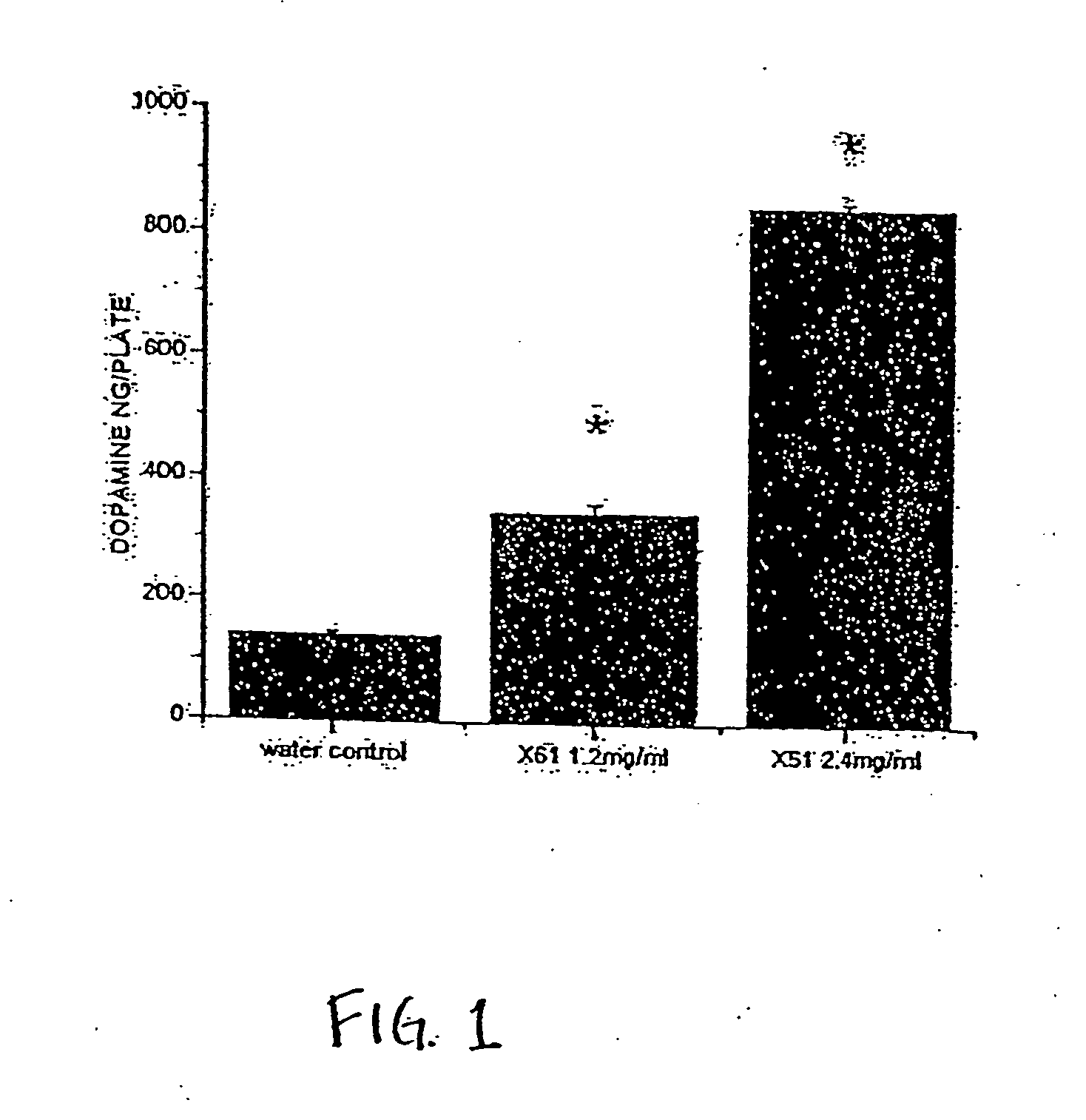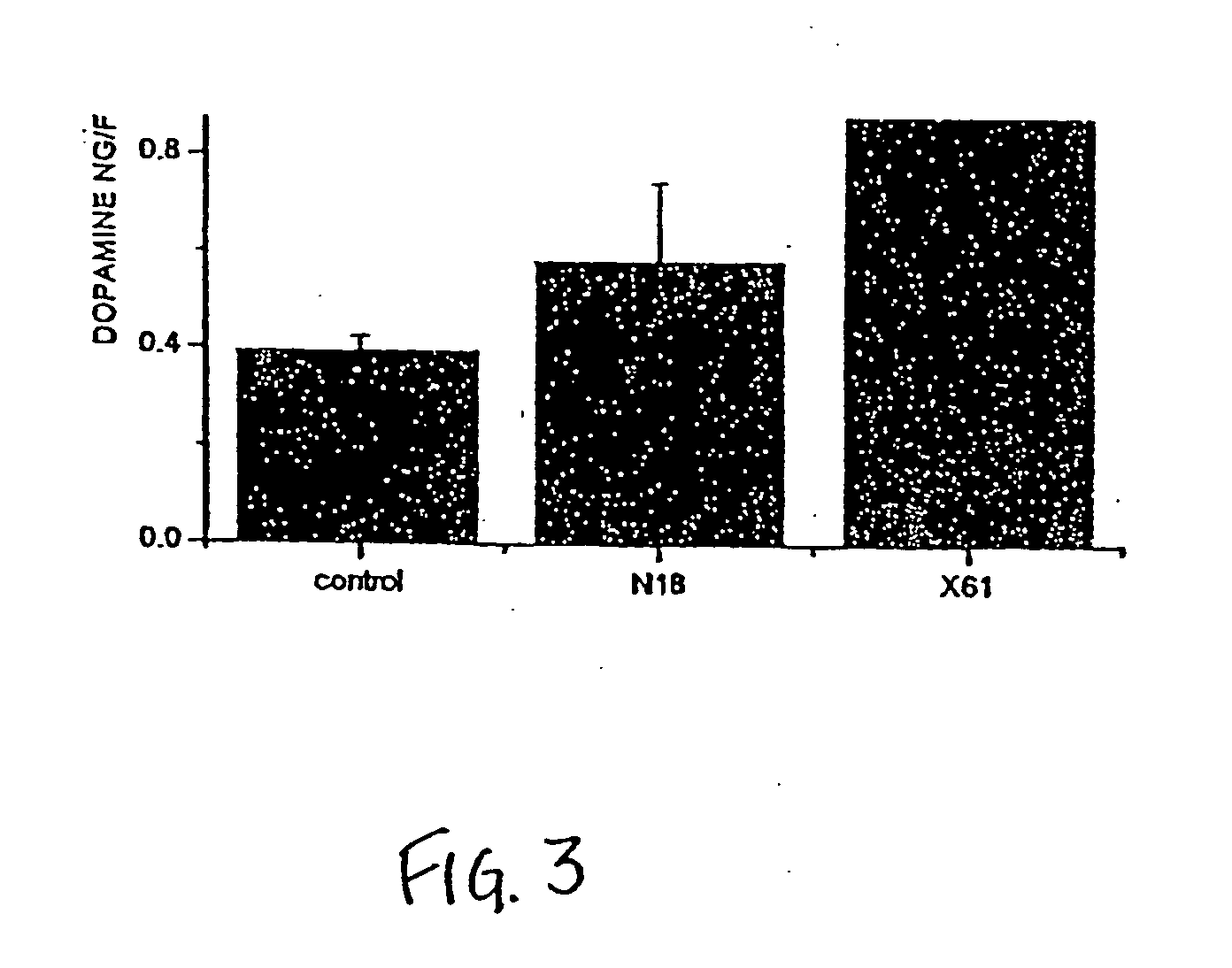Dopaminergic stimulatory factor
a stimulatory factor and dopamine technology, applied in the field of neurodegenerative diseases involving dopaminergic neurons, can solve the problems of l-dopa therapy being largely ineffective long-term, affecting the motor and psycological disability of patients with pd, and suffering considerable death, so as to increase the level of dopamine
- Summary
- Abstract
- Description
- Claims
- Application Information
AI Technical Summary
Benefits of technology
Problems solved by technology
Method used
Image
Examples
example 1
The Proteinaceous Composition Increases Dopamine in Neurons
[0130] A proteinacoeus composition, also referred to as “the X61 protein(s)”“the factor”, “the proteinaceous factor”, “the neurotrophic factor” or “the trophic factor”, of the invention, was obtained from an immortalized monoclonal line of striatal origin, the X61 cells. The factor is capable of increasing the dopaminergic content of a mesencephalic cell line, MN9D as well as of cultures containing primary dopaminergic neurons. The dopaminergic stimulatory activity was observed in the cell supernatant obtained following gentle disruption of X61 cells, an immortalized monoclonal cell line derived by fusion of the N18TG2 neuroblastoma with striatal neurons (Wainwright et al., 1995). The factor was obtained from X61 cells by washing once with 10 ml of calcium and magnesium-free Tyrode's solution (CMF) and removing the cells from the plates with a cell scraper. The cells were collected from the plates with 20 ml of CMF, transfe...
example 2
Mechanism(s) of Increasing DA Content
[0137] To define the primary cellular mechanism by which X61 protein(s) increase the DA content of MN9D cells and coaggregates containing primary DA neurons the inventors contemplate the following experiments.
[0138] In coaggregates prepared from mesencephalon with tectal cells (which are nontargets for the DA neurons), a condition in which substantial numbers of the DA neurons fail to make axons and die off, the X61 protein(s) produce a three-fold increase in DA content of the coaggregate cultures. A similar result will be sought when X61 protein(s) is applied to aggregates composed of mesencephalon and striatum (the primary target for the nigrostriatal DA projection) a culture preparation in which there is an extensive formation of DA axons and quantitative survival of these cells. The fact that protein(s) obtained from striatal derived hybrid cells increases DA levels of mesencephalic-striatal aggregate cultures, in which the majority of DA n...
example 3
The Proteinaceous Composition is a Unique Factor
[0158] It is important to note that, in general, known trophic agents function as potent survival factors, i.e., they increase cell survival either in monolayer culture or in intact brain following injury to the nigrostriatal projection. However, the trophic factor of the present invention increases dopamine (DA) levels of individual DA neurons. Although, the factor may also act as a survival factor, it is clear that the factor of the invention regulates the levels of DA in a cell. It is contemplated that the factor may function by increasing the levels of DA cell at the level of biosynthesis and / or storage of the neurotransmitter and / or may regulate gene expression of proteins involved in DA synthesis and / or storage.
[0159] Analysis of Known Trophic Factors. The inventors contemplated that the factor may be similar in function to the 14-3-3 family of acidic, dimeric proteins which exert diverse influences on the signal transduction p...
PUM
| Property | Measurement | Unit |
|---|---|---|
| Volume | aaaaa | aaaaa |
| Volume | aaaaa | aaaaa |
| Volume | aaaaa | aaaaa |
Abstract
Description
Claims
Application Information
 Login to View More
Login to View More - R&D
- Intellectual Property
- Life Sciences
- Materials
- Tech Scout
- Unparalleled Data Quality
- Higher Quality Content
- 60% Fewer Hallucinations
Browse by: Latest US Patents, China's latest patents, Technical Efficacy Thesaurus, Application Domain, Technology Topic, Popular Technical Reports.
© 2025 PatSnap. All rights reserved.Legal|Privacy policy|Modern Slavery Act Transparency Statement|Sitemap|About US| Contact US: help@patsnap.com



